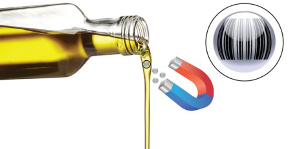Apr 26 2014
Just a few grams of the new substance are enough to tag the entire olive oil production of Italy. If counterfeiting were suspected, the particles added at the place of origin could be extracted from the oil and analysed, enabling a definitive identification of the producer. "The method is equivalent to a label that cannot be removed," says Robert Grass, lecturer in the Department of Chemistry and Applied Biosciences at ETH Zurich.
 Protecting olive oil from counterfeiters
Protecting olive oil from counterfeiters
The worldwide need for anti-counterfeiting labels for food is substantial. In a joint operation in December 2013 and January 2014, Interpol and Europol confiscated more than 1,200 tonnes of counterfeit or substandard food and almost 430,000 litres of counterfeit beverages. The illegal trade is run by organised criminal groups that generate millions in profits, say the authorities. The confiscated goods also included more than 131,000 litres of oil and vinegar.
A forgery-proof label should not only be invisible but also safe, robust, cheap and easy to detect. To fulfil these criteria ETH researchers used nanotechnology and nature's information storehouse, DNA. A piece of artificial genetic material is the heart of the mini-label. "With DNA, there are millions of options that can be used as codes," says Grass. Moreover, the material has an extremely low detection limit, so tiny amounts are sufficient for labelling purposes.
Synthetic fossil
However, DNA also has some disadvantages. If the material is used as an information carrier outside a living organism, it cannot repair itself and is susceptible to light, temperature fluctuations and chemicals. Thus, the researchers used a silica coating to protect the DNA, creating a kind of synthetic fossil. The casing represents a physical barrier that protects the DNA against chemical attacks and completely isolates it from the external environment – a situation that mimics that of natural fossils, write the researchers in their paper, which has been published in the journal ACS Nano. To ensure that the particles can be fished out of the oil as quickly and simply as possible, Grass and his team employed another trick: they magnetised the tag by attaching iron oxide nanoparticles.
Experiments in the lab showed that the tiny tags dispersed well in the oil and did not result in any visual changes. They also remained stable when heated and weathered an ageing trial unscathed. The magnetic iron oxide, meanwhile, made it easy to extract the particles from the oil. The DNA was recovered using a fluoride-based solution and analysed by PCR, a standard method that can be carried out today by any medical lab at minimal expense. "Unbelievably small quantities of particles down to a millionth of a gram per litre and a tiny volume of a thousandth of a litre were enough to carry out the authenticity tests for the oil products," write the researchers. The method also made it possible to detect adulteration: if the concentration of nanoparticles does not match the original value, other oil – presumably substandard – must have been added. The cost of label manufacture should be approximately 0.02 cents per litre.
Labels for petrol and Bergamot essential oil
Petrol could also be tagged using this method and the technology could be used in the cosmetics industry as well. In trials the researchers also successfully tagged expensive Bergamot essential oil, which is used as a raw material in perfumes. Nevertheless, Grass sees the greatest potential for the use of invisible labels in the food industry. But will consumers buy expensive 'extra-virgin' olive oil when synthetic DNA nanoparticles are floating around in it? "These are things that we already ingest today," says Grass. Silica particles are present in ketchup and orange juice, among other products, and iron oxide is permitted as a food additive E172.
To promote acceptance, natural genetic material could be used in place of synthetic DNA; for instance, from exotic tomatoes or pineapples, of which there are a great variety – but also from any other fruit or vegetable that is a part of our diet. Of course, the new technology must yield benefits that far outweigh any risks, says Grass. He concedes that as the inventor of the method, he might not be entirely impartial. "But I need to know where food comes from and how pure it is." In the case of adulterated goods, there is no way of knowing what's inside. "So I prefer to know which particles have been intentionally added."